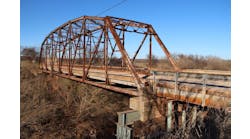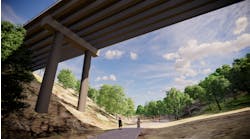The corrosion of post-tensioned (P-T) tendons in the nation’s bridges has become an increasingly significant problem.
A growing awareness of the situation has prompted state departments of transportation to step up inspections of their P-T structure inventory, assessing and quantifying the rate of tension corrosion and estimating the remaining service life of the affected member.
To heighten P-T corrosion awareness, the Federal Highway Administration (FHWA) recently released memorandums about potential tendon corrosion for a list of P-T bridges constructed using grout that may contain elevated chloride levels. The potentially affected bridges and maximum limits for chloride levels are being investigated further.
Separation disorder
Corrosion of steel is prevented by surrounding it with a high-pH environment such as that found in cementitious materials like concrete or grout. Primary protection is provided by the formation of an alkaline (passive) film on the surface of the steel, resulting from reactions with its rich pH environment. Increased concrete or grout cover provides additional protection from dissolution of the protective alkaline film. Experience indicates that the protective film becomes compromised when the pH at the steel-concrete interface falls below 10 and/or the chloride concentration rises above a threshold level.
Typically, the pH of fresh concrete or grout is 13 or higher. However, the pH of concrete or grout can be reduced through carbonation, where atmospheric carbon dioxide reacts with cement alkali to yield carbonates. Carbonation generally occurs at a rate inversely proportional to the quality of the grout (i.e., high-quality grout yields a low carbonate rate) as defined predominantly by its water-to-cement ratio.
The American Concrete Institute (ACI 222R-89) limits the maximum allowable chloride concentration for prestressed concrete structures to 0.08% (acid soluble) by mass of cement. However, this value applies to fresh concrete or grout that is fully alkaline. The chloride threshold becomes progressively lower with decreasing pH or carbonated concrete.
In post-tensioned structures, stressing tendons are placed in ducts filled with grout for protection from corrosion. But during grouting operations there is a tendency for bleed water and fines to separate and move ahead of the grout mass, depending on the grout quality, grout admixtures, pumping procedures and equipment. The separation of grout during pumping results in low-pH grout around the tendons and voids at tendon high points and anchorages, which increases the potential for corrosion at these locations.
Over the years, occasional tendon failures, and in some instances structural failures, in P-T structures have been attributed to corrosion resulting from poor grout quality (low pH and/or high chloride concentration) and inadequate grouting methods. Therefore, it is critically important to quantify the level (rate) of corrosion in the tendons of P-T structures in situ rather than simply identifying it.
Full time on P-T bridges
In order to provide a complete service package to address the problem, URS has formed a partnership with Siva Corrosion Services (SCS) and VStructural (VSL). The new package will enable their clients to perform visual inspections, corrosion testing, sample testing and design repairs to rehabilitate or strengthen P-T bridges. To date, the URS-led partnership has successfully serviced 29 P-T box-girder bridges and one P-T pier cap—18 in Oklahoma and 12 in Indiana—varying from internal to external P-T tendon types. The team also has been selected to work on five P-T bridges in Alaska.
Various levels of evaluation are deployed, based on experience and statistical sampling, to quantify the rate of corrosion. The American National Standards Institute (ANSI) provides guidance for the number of inspection locations based on statistical methods.
Visual inspections complemented by borescope inspections are a preliminary means of identifying areas of corrosion. However, to quantify the rate of corrosion, judicious use of electrochemical and nondestructive evaluation (NDE) tools must be used. These NDE tools include infrared cameras, ground-penetrating radar, ultrasonic tomography, impact echo and corrosion-rate probes.
In addition to the NDE tools, monitoring a bridge’s dynamic response is an effective method of assessing its in-situ condition. Sensors are used to estimate tension in P-T tendons, and sensor measurements of frequency and damping response can help identify conditions that may allow for strand corrosion. Also, measuring the overall response of the structure provides insight to its performance from a global perspective. Establishing baseline requirements enables comparison with subsequent measurements to identify locations of degradation and changes in the structure’s global behavior.
When the evaluations are complete, any damage to the P-T ducts is repaired, and any voids in the ducts are filled with a zero-bleed grout of compatible composition by an appropriate grouting method to slow further corrosion.
Based on the information
With the appropriate factors and locations of corrosion identified, owners can make informed decisions on remedial actions to slow further corrosion, such as sealing cracks, filling voids in P-T ducts appropriately with grout, installing corrosion-mitigation systems at tendon high points and anchorages, or a combination of such methods. Sacrificial corrosion-protection systems are becoming more prevalent in the design of new P-T structures. Results from corrosion evaluation are used to locate areas in need of strengthening or rehabilitation.
Of the 18 P-T box-girder bridges evaluated in Oklahoma, more than half of the bridges had voids around the P-T tendons in excess of the ANSI standards, requiring all tendons within those structures to be borescoped for voids. After evaluations were complete and results presented, the client made an informed decision to have all voids filled with suitable grout and to employ techniques to slow further corrosion of tendons. Results from the evaluations guided structural engineers to areas that required strengthening or rehabilitation.
The grand scheme
The corrosion-evaluation program is part of an overall agenda of bridge instrumentation and evaluation applications. These include:
Bridge load rating for strength evaluation
Field load testing helps to understand actual structural behavior, identify and quantify inherent load-carrying mechanisms that are considered in conventional analysis, and discover hidden structural deficiencies, if any. Bridge load testing usually results in improved load ratings.
Fatigue life assessment and crack repairs of steel bridges
Field measurement of stress-range histograms at concerned fatigue details proves to be the most reliable method for quantifying live load and temperature effects for evaluation and retrofit of load-induced or distortion-induced fatigue cracks, or assessment of remaining fatigue lives.
Service condition monitoring for concrete cracking or excessive vibration
Continuous monitoring of crack opening/closing activities or measurement of structural-vibration characteristics correlates the local driving force for cracking or dynamic responses with the actual loads/temperatures the bridge is subjected to, helping to develop effective retrofits.
Tension assessment in cables or post-tensioning bars
Existing tension forces in cables or P-T bars can be accurately determined using the noninvasive and rapid Taut Cable Vibration Measurement (TCVM) method, which only requires measuring the acceleration time histories, free vibration length and mass density of the cable/bars.
Balancing of movable bridges
Balancing of trunnion-type bascules, lift, rolling lift or swing spans can be evaluated through field instrumentation by continuously recording the torque in the driving shafts and/or hydraulic pressures in the driving cylinders as well as the motion of the leaves during opening and closing.
Diagnosis and retrofit of structural problems
Accurate diagnosis of structural problems often requires combined finite-element analysis and field testing/measurements. The computer models, after being calibrated by field testing, can predict behaviors of complex structures for various load combinations and extreme loading conditions.
Continuous wireless monitoring of bridge performance
Performance parameters such as movements of expansion bearings, opening/closing activities of existing cracks and displacements of key elements reflect actual structural behavior and load distribution. Continuous monitoring of these parameters through wireless communication provides value to bridge maintenance and repair decisions. R&B


